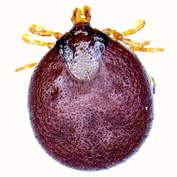Dorsal view of an echidna tick, Bothriocroton concolor. Credit: Siew-May Loh
Murdoch University researchers have detected a new species of bacteria in echidna-biting Australian ticks.
The recent discovery was published by Dr Charlotte Oskam, from Murdoch University's Vector & Water-borne Pathogen Research Group (VWBPRG), in the parasitology journal Parasites and Vectors. To date, little has been documented about microorganisms harboured within Australian native ticks or their potential to transmit disease.
The study concentrated on ticks removed from echidnas on Australia's east coast of Australia, with researchers discovering the presence of a Borrelia bacteria species separate to a group of bacteria which causes Lyme disease in the northern hemisphere.
While the new species is genetically related to the Borrelia group causing tick-borne Relapsing Fever (RF) overseas, its discovery has the potential to form its own major bacteria group.
"Just like our native wildlife, the new bacterium discovered is unique to Australia and unique to ticks that bite echidnas," said Dr Oskam.
The new bacterium was found in ticks removed from echidnas in Queensland and New South Wales, but not in Victoria, with Dr Oskam admitting further research was needed to uncover the disease potential and consequences of the bacteria.
"We don't know at this stage whether this new bacterium can cause disease or if this bacterium can be transmitted by ticks. It's too early to say," she said. "Also of note is this type of tick doesn't bite humans – it prefers echidnas – so we need more information about this particular Borrelia. For example, it's present in echidna ticks but can we find it in the echidnas themselves?"
Ticks transmit the most diverse range of animal-to-human pathogens of any arthropod – a major concern to the health and wellbeing of humans, wildlife, livestock and companion animals. For many pathogens transmitted by overseas ticks to wildlife, the animal is rarely affected.
"But when people go into these environments and get bitten, they can get sick," Dr Oskam explained.
This is why the VWBPRG at Murdoch University is looking at bacteria in native ticks and their wildlife hosts.
"By looking at the wildlife, we can start piece together a view of what could cause illness in humans," added Dr Oskam.
The discovery of the new bacterium in ticks was made possible thanks to next generation sequencing technology, first investigated by PhD student Alex Gofton. Mr Gofton's recent molecular survey of bacteria associated with native Australian human-biting ticks identified a Borrelia related to the RF group removed from an echidna host. This technology enabled Dr Oskam and PhD student, Siew-May Loh, to tailor their research to look specifically at echidna ticks.
Three borreliae have been previously reported in Australia, transmitted ticks associated with cattle, poultry and longhaired rats.
More information: Telleasha L. Greay et al. A survey of ticks (Acari: Ixodidae) of companion animals in Australia, Parasites & Vectors (2016). DOI: 10.1186/s13071-016-1480-y
Siew-May Loh et al. Novel Borrelia species detected in echidna ticks, Bothriocroton concolor, in Australia, Parasites & Vectors (2016). DOI: 10.1186/s13071-016-1627-x
Provided by Murdoch University






















